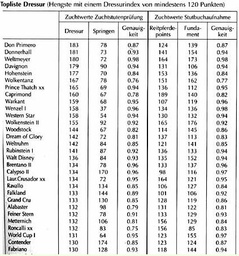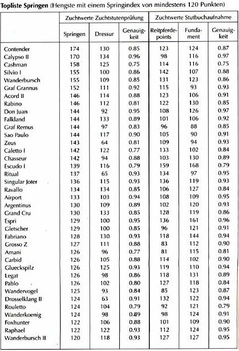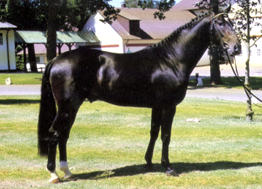Breeding statistics
Which stallion for what mare?
Here are the statistical rankings from the Hanoverian Yearbook
Below you will find an interview with Dr Ludwig Christmann, of the Hanoverian Verband which explains the ways the standings are calculated...
dressur = dressage, Reitferdepoints = typeyness, springen = jumping (freejumping), Fundament = limbs, Genauigkeit = accuracy
Statistical Guides to Breeding
an interview with Ludwig Christmann
All through Europe the search is on to find 'scientific' ways to help performance horse breeders, and most of the major stud books have some sort of objective ranking for their stallions, and in some cases, mares. Dr Ludwig Christmann of the Hanoverian Verband outlines some of the ways his breeding organization uses this statistical material - and in particular, outlines the way in which mare performance tests can be used to provide a 'fast track' check on a new stallion. And as Ludwig explains to Chris Hector sometimes those 'objective' rankings can produce quite misleading results!
How many forms of 'objective' statistical rankings are you using in the Hanoverian Verband?
We have the rankings from the scores of stud book inspections, from mare performance tests, and also the rating from the performances in competition. The two main rankings are from the prizemoney awarded in competition, and from the mare tests and stud book inspection. We also receive a nation wide ranking from our national equestrian federation in the Breeding Annual.
The rankings that we are producing from our own scores have some advantages over the other systems; because the mares are tested at the age of three or four, then the scores are available earlier, when the stallion is still young. For the stallions that are used very heavily we get the scores when the oldest offspring are three, when the stallion is eight or nine years old. Our rankings have a higher heritability factor than the competition rankings. A very big advantage is that you are getting information on all the qualities of the mare tested, while the FN rankings are based on competition, which means that the individual offspring is only tested for either dressage ability or jumping ability - with our mare tests, the offspring are tested in both dressage and jumping, so you then get a ranking which shows something of the stallion's influence on both jumping and dressage.
Are the Hanoverian rankings in general agreement with the FN rankings?
Recently we had some problems with the FN rankings, especially with the jumping sires. If you take the example of Donnerhall, he only has very few horses in jumping competition, but if they are very good horses, then he can get a very high jumping index. Another example would be Wenzel who has had about three hundred horses successful in dressage but only ten that were successful in showjumping. Of these ten, two went up to Grand Prix level in jumping, and so Wenzel received a relatively high jumping score. But it is not accurate when you take into account the very low number of jumping horses he has produced within his overall progeny. Because they do not expect Wenzel progeny to jump, it is only the exceptional very good jumpers that are given the opportunity to compete. Unfortunately the FN figures do not take into account the level of participation, and so that can give a rather distorted picture.
Another problem is that the FN figures are adjusted for the placing in the competition. In former years rankings were based on the prizemoney, now when you have a first place in a low level competition, and you are above the average prizemoney for that competition, then you get a bonus. So if you win a very low level class you get more points than you do for a tenth place in the Grand Prix at Aachen, so that doesn't make sense.
The problem of ranking on the basis of competition is that the riders have already 'pre-selected' the horse, and you do not get a complete picture of the progeny of the stallion - whereas with our mare test results we get almost a total picture. We inspect 2,500 mares every year, and out of these, 1600 are performance tested and from these tests we get information on both dressage and jumping ability - there is not a strong element of pre-selection so you get a better picture of what the stallion is producing.
The problem we have with the mare test is that we are dealing with young horses, three year olds, and we cannot look into the future as to how good the horse will be - we can just say that the horse is talented for dressage or for showjumping, but we can never know how far the horse might go. Some horses take a little longer to show their ability and this creates a problem.
For example with Grannus, he himself was a late developer - he didn't pass his performance test but later was a high class performer. His offspring are also very often not very successful in Young Horse Classes, but they are very successful later on. Axel Brockmann who is Dr Bade's assistant at the State Stud, Celle, did some calculations, comparing our mare test results with later competition results, and we found a good positive correlation - a correlation of .60 which is pretty good.
How many mares do you need to test before you can give the stallion a meaningful rating?
About fifteen mares per stallion is enough. The heritabilities are quite high, about 30% for the traits we are using, with fifteen mares we get quite accurate results. Of course, when you have fifty or sixty mares at the end, the accuracy is even better still.
How influenced are the breeders in the Hanoverian area by these 'numbers' - or do the 'objective' rankings only confirm what good breeders know anyway?
I think they will use these tables more in the future. We only started last year to publish these results, but the demand is starting to come from the breeders. I think the demand will grow, because now in the age of artificial insemination, you have some stallions that are very heavily used at a young age, and you need an evaluation of their progeny at an early stage. Otherwise it is dangerous, if you have a stallion that has a problem and you do not discover it early... Breeders are increasingly using stallions that are not standing in their area, and so often they don't get to see the offspring, sometimes not even the stallion, so they need some objective information on which to base their decisions.
We feel that the breeding values should not be the only thing the breeders base their decisions on. They should still have their own breeding instincts, it's just a help for the breeders to make sure that the stallions they have chosen are the right ones. It is more to confirm the 'gut' feeling of the breeder. Obviously you should not only breed according to the numbers, you must still look at the mare, and think about what stallion matches the individual mare. Where does my mare have weaknesses, how can I adjust this with the right choice of a stallion? It is no good to say, this is the stallion with the highest breeding values therefore it must be the best. The stallion in place fifteen might be a better choice for that mare than the stallion at number one.
How available are those figures?
They will be updated every year and they are available to everybody from our Verband office.
You don't think this is tearing up the traditional breeding base - where breeders used the stallion sent to their local station, and you created a very concentrated mare population to breed the stallion to?
I think it is more the other way round. Now the stallions are bred to a greater variety of mares and so you can see much better what bloodlines he works with. If you only breed to a very limited mare population with only a certain pedigree - then you can only say the stallion fits very well, or not at all, to the mares in a certain area.



